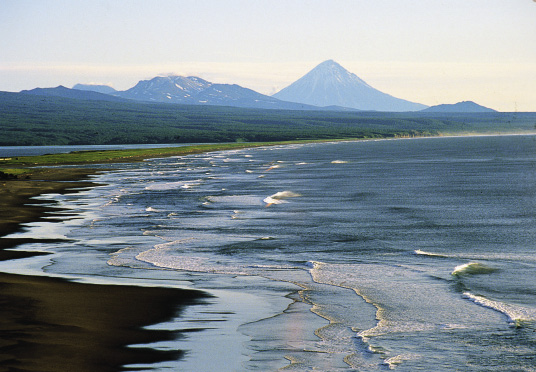KAMCHATKA WAS DISCOVERED BY THE RUSSIAN COSSACKS MORE THAN THREE CENTURIES AGO, BUT EVEN TODAY MOST PEOPLE DON’T KNOW MUCH ABOUT IT. THE MYSTERIOUS PENINSULA USED TO BE ONE OF THE SO-CALLED “CLOSED” TERRITORIES IN THE USSR: THE FIRST FOREIGNER ONLY SET FOOT THERE IN 1990, AND EVEN RUSSIANS NEEDED A SPECIAL PASS.
TEXT: MAXIM KOVALYOV,
IRINA MARKELENKOVA

Today Kamchatka is open to travellers, the number of whom grows each year. They all recognize the land’s extraordinary spirit and the warm hospitality of local residents.

The Kamchatka Peninsula is the largest in Eurasia, with a sea coast, lakes and rivers, forests and, of course, volcanoes. Mountains occupy three quarters of the peninsula, with as many as 36 active volcanoes.

Volcanoes are an iconic feature of Kamchatka – no wonder that they are included in the UNESCO World Heritage list. You can see them first even from the plane. The socalled “domestic” volcanoesare lined up in a slender chain just 25 kilometres from the region’s capital, Petropavlovsk-Kamchatsky. There are five of them: Aag (2,310 metres above sea level), Arik (2,156 metres), Koryaksky (3,456 metres), Avachinsky (2,751 metres) and Kozelsky (2,189 metres). Two of those giants are active: the locals affectionately call them “Koryaka” and “Avacha”. Downhill skiers and snowboarders come in the winter, spring and even summer, while mountain climbers conquer their steep slopes all year round.

The beautiful Klyuchevskaya Sopka Volcano (4,750 metres above sea level) is the pride of the region, the highest active volcano in Eurasia. This giant erupts regularly every 4-6 years, with the last eruption complete with lava recorded in 2017.

Many tourists, mountaineers and fans of extreme sports fl ock to its foothills and try to reach its summit.
Anyone who steps into this magical land is overwhelmed by its pristine nature. You can see all kinds of animals here: bears and foxes, wolves and hares, sheep and deer. Kamchatka is also famous for its marine resources and is justly called the “Salmon Paradise”.

You can come here at any time of year. The mountain summits are snow-covered virtually all year long, giving sportsmen and tourists the opportunity for year-round skiing, heli-skiing and snowmobiling.
Kamchatka residents celebrate Volcano Day every year. It takes place in the middle of August, when Kamchatka’s nature frees itself from the shackles of winter and lets travellers reach its most secluded nooks and crannies untouched by civilization. The celebration’s key event is the climb of the Avachinsky Volcano. On Kozelsky Volcano, among ranges and snow-covered ridges, creative and extreme workshops, master classes and demonstration lessons take place.

You can reach these “domestic” volcanoes by all-terrain transportation either on your own or as part of a tourist group. It is easy to choose a travel company: the Travel and External Aff airs Agency of Kamchatskiy Krai’s website (agtur.kamgov.ru/reestr-turoperatorov) off ers a list of travel agents.
Getting THERE
How to get there
The distance from Moscow to Yelizovo airport in Petropavlovsk- Kamchatsky is 6,773 km or 8.5 hours by air. There are regular fl ights to Kamchatka from Moscow, St. Petersburg, Yekaterinburg, Samara, Novosibirsk, Magadan, Krasnoyarsk, Vladivostok, Khabarovsk, Irkutsk and Anadyr, as well as charter fl ights from the United States and Japan.
Where to stay
Petropavlovsk-Kamchatsky has many hotels, from economy to luxury, as well as guest houses, inihotels
and hostels. They welcome guests all year round. During highsummer season, it is better to book a room in advance.
What to buy
As for souvenirs, it’s worth looking at wooden fi gures of traditional Kamchatkan talismans – peleken the jolly man, and kutkh, the embodiment of the spirit of the raven.

